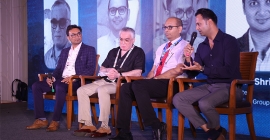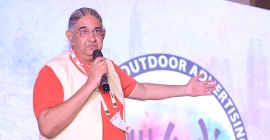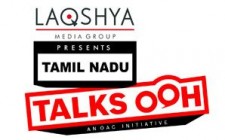Chennai & Rest of Tamil Nadu: Revving up for a smooth takeoff
By VJ Media Bureau - May 08, 2015
Progressive outdoor policies, concerted efforts by the industry to project the regional markets and engage national brands, and long-term project partnerships between civic boides and OOH players will provide the much-needed thrust for the OOH industry to board a higher growth trajectory
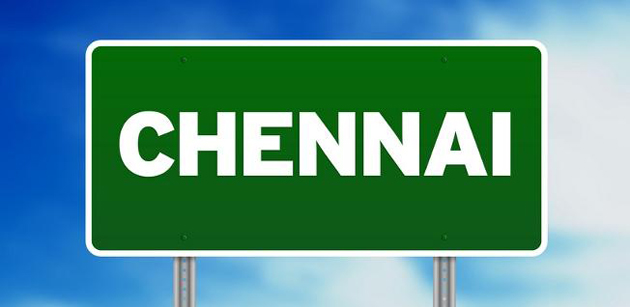 There's a certain buzz about Out-of-Home (OOH) advertising in Chennai and rest of Tamil Nadu, although the OOH landscape of Chennai is not dotted with large formats like most cities are. Reports suggest that the Corporation of Chennai is looking at opening up the outdoor advertising industry in the city, such that it brings greater revenues to the city's civic body. The Corporation has apparently engaged with consultants from Tamil Nadu Urban Infrastructure Financial Services Ltd (TNUIFSL) to chalk out a plan that will lay the foundation for an organised way of doing the OOH business in the city.
There's a certain buzz about Out-of-Home (OOH) advertising in Chennai and rest of Tamil Nadu, although the OOH landscape of Chennai is not dotted with large formats like most cities are. Reports suggest that the Corporation of Chennai is looking at opening up the outdoor advertising industry in the city, such that it brings greater revenues to the city's civic body. The Corporation has apparently engaged with consultants from Tamil Nadu Urban Infrastructure Financial Services Ltd (TNUIFSL) to chalk out a plan that will lay the foundation for an organised way of doing the OOH business in the city. At a Council meeting in January 2015 in Chennai, a resolution was passed to impose fixed charges for advertisements other than hoardings on Corporation properties at Rs 500 per sq m. In the subsequent meetings, involved discussions have made it possible to look at maximising revenues through taxation policies to tap the outdoor medium.
Hence, the stakeholders in the OOH business are seeing this as a welcome step and an opportunity to use public utilities in a better and effective manner. They are keenly awaiting the government regulation to help them to get a stronger foothold in this media that has been rapidly growing in all other locations in the country.
 HIGH ON POTENTIAL
HIGH ON POTENTIALAtul Shrivastava, CEO, Laqshya Media, asserts that the Chennai OOH market has high growth potential. Most national campaigns are executed in the Chennai market too, although at times brands do not easily get media for their campaigns. Yet, the OOH media in the city is relatively cheaper than media in Delhi and Mumbai. Brands find it cheaper to advertise in Chennai as spends on bus shelters seems a lot lesser than those on large formats. At the same time, bus shelters provide the reach and frequency to brands.
Across key markets, street furniture is becoming more important, so Chennai OOH market is not off the radar. He adds, "Today bus shelters are very well fabricated and maintained, so they make a good medium for advertising.â€
Laqshya is one of first firms in the world to develop air-conditioned bus shelters in Dubai. However, the firm is not looking to replicate it in Chennai owing to problems like vandalism. Shrivastava says there is also scope for engaging OOH firms in developing public conveniences in Chennai on PPP basis in lieu of ad rights. "Buses will become a big OOH medium with the introduction of modern fleets. Airport, mall and railway media are also coming up in a big way in the city,†he points out. Laqshya holds rights on over 200 bus shelters in Chennai, of which it has installed 75 and another 65 already exists.
 BROADER ENGAGEMENT
BROADER ENGAGEMENTD Muralidharan, MD, SSI Media India, an industry veteran, who continues to operate in this challenging environment, provides valuable insights. "Reaching out to clients directly seems to pave the way for doing business,†he notes, citing the recent case of suggesting an annual plan to a'ghee' brand -- that is fast gaining popularity - to include the OOH medium in its marketing plan. His advice is simple. Reach out to clients who are misdirected by agencies to either ignore the OOH market or who not consider spending in this medium.
Muralidharan says, "We recommend clients to apportion a minimal portion of their brand budget for the OOH medium. By releasing a jacket ad in a leading national daily may register the brand's identity. But the phenomenal spend is helping the brand only temporarily. Instead, if the OOH spend can also be included, then the gain is more permanent as the scope for building the brand is enhanced. Also, we are enabled with an opportunity to provide package deals as the assurance of outcomes using the OOH medium is far more grounded.â€
Citing the example of a famous jewelry brand using all forms of media for announcing its launch in the metro, he said the campaign spend on outdoor media, which could have been around Rs 2.5 crore, has given the brand visibility for a longer time period of 45 days whereas the print and electronic media were short-lived.
Directly connecting with prospective clients is the trend that is fast catching up as agencies are giving a royal go-by to the metro, which incidentally happens to be the prime centre for all kinds of product launches. Chennai is seen "merely as a test market,†is the common lament. Agencies do not recommend to their clients to use the OOH medium in this geography as it is conservative as well as a challenging market that has not managed to be taken as a serious one among the campaigners. That it fails to be projected as a vital component of a branding strategy has been a cause for disappointment for everyone in the OOH space. This is the main reason for OOH players to reach to their clients directly giving the agency the same treatment it metes out to them!
Muralidharan also feels that the market is not well-organized. Estimating 10 players to be active in the market, he says, it is the misconception of making'quick bucks' that has not only spoilt the trade but also responsible for declining business. Apart from this, wrong advice to clients with not enough homework being done continue to stunt the growth trajectory. Squarely blaming the agencies for "deceiving†the clients, he says that this is one of the reasons for mall branding too not picking up as could otherwise be possible.
With the emergence of more professionally-managed companies, the entry of new-gen entrepreneurs and the taking over of reins by the next gen, directly reaching out to clients is proving to be an effective approach. For instance, his firm has signed up with a regional bank from Tamil Nadu, which is committed to spend Rs 3 crore on brand-building efforts. An assured sum of about Rs 14 lakh per month has led him to offer the lucrative terms for an annual contract. More FMCG companies and banking sector seem to be resorting to the OOH medium.
 UPGRADE INFRASTRUCTURE
UPGRADE INFRASTRUCTUREK Vasantha Kumar, Founder & MD, Airvoice Advertising, asserts that the growth of Chennai OOH industry is circumscribed by lack of advertising space. Yet, OOH media owners have to meet client expectations with the options available at hand. As such, hoardings will reduce in number in all cities with more sophisticated urban planning.
So, will media owners be called upon to develop innovative media formats? On this, Kumar says that a greater use of digital OOH will meet the innovation imperative. "We have to start planning in a manner that digital OOH becomes a part of outdoor advertising,†he says.
As bus shelters constitute a large part of OOH media in Chennai and as the city has a warm climate for major parts of the year, Air Invoice is planning to convert many of the shelters on which it holds rights into AC bus shelters. "There is ample scope to develop the physical infrastructure in Chennai through public-private partnerships wherein OOH players can develop infrastructure like skywalks in lieu of advertising rights. Construction of public toilets in the PPP mode with ad rights will also interest the OOH industry,†he says.
According to him, OOH players in Chennai are comfortable with investments in projects that span 3-5 years. As regards Chennai's rise as a major consumer brand destination, Kumar says Chennai's OOH industry has not projected itself as much as it should have. Buses are the most popular mode of transportation in Chennai and ROTN, so it serves as a powerful OOH media as well. If the buses are well-maintained then using it for branding purposes will attract more advertising, says Kumar. Coimbatore, Trichy and Madurai are the three major markets other than Chennai.
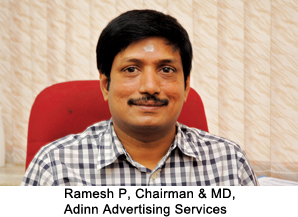 REDUCE RESTRICTIONS
REDUCE RESTRICTIONSUnderlining the growth potential of OOH business in Chennai & ROTN, Ramesh P, Chairman & MD, Adinn Advertising Services, opines that currently brands use hoardings, bus shelters, traffic signals and police booths for their campaigns in the region. "Over the past two decades national brand advertising in the regional market has grown at an impressive rate,†he says.
As regards regulations, he says that the authorities should not impose too many restrictions on the industry. "Legalising of hoardings will not only help the industry but also society as a whole. It is imperative to have a single-window permission process for outdoor advertising,†he says. Besides, the rates should be reasonable and attractive to the brands. "Moreover, the ad community should try to function within the dictates of their conscience.â€
When asked if absence of billboards is hurting the industry, Ramesh said, "I do not subscribe to the view that there are no billboards in the city. Yes, they are fewer in number. However, I don't see other formats picking up in the city.†He is quick to add that transit media has a big presence in the urban areas with "vast room for growthâ€.
On whether the regional market is ready for digital OOH media, he says, "Although there are encouraging signs, it is still not ready. But, once adopted, it will act as a catalyst for growth.â€
Ramesh reckons that cooperation between the prime stakeholders - the Government, local bodies and the OOH players - is essential for the development of physical infrastructure. Effective coordination, mutual cooperation and support from agencies concerned can result in greater good for the public.
 PLENTY OF CHOICE
PLENTY OF CHOICEHoardings, the mother of all media, as J Pragash, MD, SSB Media, notes, continue to be the key driver for supporting all kinds of branding campaigns. "Usage of more sq ft means more money! Regularising the hoardings in the metro will certainly assist the players tremendously.
Unlike other metros, Chennai has challenges that are curbing the growth of the trade. The problems are unique to the state capital only as we have been able to tap the potential in ROTN by offering a diverse spread of OOH categories. Bus shelters, hoardings, mobile vans, traffic signals and several other formats of advertising are fairly easily available in these locations. Our USP is our presence in 23 districts, apart from Chennai. Our range of services are available almost everywhere be it Krishnanagar or deep down to Tuticorin,†he says, highlighting the company's efforts to expand its footprints in 10 more districts in the near future.
The advertising professional, who took the entrepreneurial plunge, says the perception of Chennai being seen as an extinct market among brand campaigners, is not right. "Despite the dynamics of state regulations preventing the use of hoardings, it is business as usual. Planners would do well to consider the immense potential that the location offers,†Prakash says, observing that a direct approach with clients has contributed to the silent growth of the OOH medium in this southern part of the country.
 ONE VOICE
ONE VOICEFor those in the OOH business, there is yet another worrying factor to contend with. They are not organised enough to represent as a strong and united body to the government. The association is not only dormant but also dwindling in numbers. "We lack the ability to forge ahead as a serious representative body. We are only using our connections and networking abilities to strike business deals,†notes V Ponnappan, MD, Loyal Ads.
Owners of hoardings have started trading in Bangalore and other markets on the back of their experience in doing business in Chennai and Tamil Nadu. Kerala too appears to be a lucrative market for those in the hoarding business. Regularising the business could change the whole scenario, he says, pointing out that only those who own sign sites operate without any fear.
Though other outdoor mediums are available, hoarding is the best, he says, adding that clients are willing to spend a premium for even a shorter duration of using it. So, if these are authorised, there is enough and more for those in the business. Traffic signal advertising, presently, is the fast moving category of branding for the Rs 10 crore Loyal Ads, which is aiming to double its turnover in the coming years.
Efforts to be innovative by trying to replicate successful models have neither won any appreciation nor any deal. "We felt inspired to see the use of digital media in the pillars (underbelly) that support flyover and highway structures in Malaysia. A detailed plan submitted to the government authorities has not yielded any positive result,†he laments, pointing out that such innovative attempts will also help in beautifying locations as these do not require any break-down of the existing infrastructure.
FMCGs and retailers have benefited hugely by using the outdoor media, he says adding that his experience of connecting with clients directly has been far more gainful. "Media owners should call the shots instead of the agency which is now dictating the terms,†he said.
 INDUSTRY STATUS
INDUSTRY STATUSOther voices in the OOH business too feel that a tough market, coupled with not having an'industry' status and no clarity on policy, have dented the confidence of those in this business. "There is a lot of revenue potential in the outdoor media. But convincing the right people about the revenue source can work wonders,†V C Vethanantham, spearheading the Erode-based Guru Media Marketing Pvt Ltd, opines. Indian Railways, earmarking a massive Rs 9,000 crore for branding across country, is a classic case of the huge business potential. If those in Tamil Nadu can get a pie of this, the effective use of outdoor media is possible. Public utilities, be it bus shelters, CCTV camera-related branding, traffic signals and a host of other categories, offer tremendous scope for OOH.
According to him, it is the knack of communicating and reaching out to the authorities about the humongous potential of the outdoor medium is what can trigger a positive turn, which will be a win-win for all the stakeholders. He also believes that routing through the agency has worked in his favor as the scope for associating with big brands is enhanced. "While working with local clients may facilitate payment and branding efforts, partnering with agencies has more advantages. Routine business and an opportunity to work for large brands are aspects that cannot be ignored,†Venthanantham said, likening the approach of directly reaching clients and working with the agencies as being two eyes. "Both are equally important. One cannot say I need only one eye,†he points out.
 STREAMLINE BUSINESS
STREAMLINE BUSINESSDitto is the sentiment of C Prasath of Widener Ads, who says that global agencies mandate certain requirements. Therefore, partnering with these agencies not only gives a chance to work for big brands but also reduces the marketing costs.
He accepts that there is a lot of variation across geographies when it comes to the outdoor media. But, "OOH has great demand. Streamlining and regularising the trade (use of pentamedians - like in Andhra and Kerala, foot-bridges - in Karnataka) can yield great benefits to one and all,†he notes.
Smaller towns like Kumbakonam, Thanjavur and Sathyamangalam have been using the outdoor medium more and it is a popular component of a branding strategy, he said, adding that clients are spending 30% of their budgets on OOH in these non-metro locations.
Of course, he admits that compared to other states, neighbouring states in particular, OOH is weak. Few years ago, the spread of media was diverse and many. From an availability of 100 plus formats of advertising, the options have shrunk, when it comes to recommending to the clients. The challenges in Tamil Nadu have led to the exit of many players. But, newcomers are entering the fray, he said.
According to him, a built-own-transfer (BOT) modeled approach of business can cause a huge positive impact. This exists in other places while in the state and Chennai it is not a widely used model. Foot over-bridges branding is concentrated in few pockets, Prasath says, pointing to the OMR IT corridor as one instance. Encouraging this model would mean a'win-win' for all the stakeholders.
Though OOH is the cheapest media as far as a branding strategy is concerned, the clients' spend has been declining and has diminished by almost 50% in Tamil Nadu. Business uncertainties are driving out operators to other locations. Investing a mere sum of Rs 10 lakh on OOH can result in a decent outdoor campaign unlike the enormous spends required for the electronic media, he said.
Widener Ads that was clocking a turnover of Rs 16 crore in 2008-09, has found the going tough in the subsequent financial periods. A slowdown in the real estate business too has hit the business. In boom time, the infrastructure category would constitute between 25 and 30% of the total market. Hoardings, as a larger format, works well in brand recall, he said, highlighting the successful Hutch'pug' campaign that manages to still being a vivid brand campaign despite the brand itself changing to'Vodafone' now. Categories, like telecom branding, too have not been showing good results in the last two years.
Question him about digital media, he says the potential is immense but the story is one of not enough awareness about the media.
So, when it comes to digital branding too, Chennai and the state clearly lags behind. But for the sparse use of the medium, awareness is poor.
Also, the existing challenges for use of traditional OOH media have only been a deterrent instead of encouraging the stakeholders to look at newer and emerging formats of OOH. Therefore, convincing clients to upscale their brand spends in this medium is getting far more difficult.
If a revenue projection of Rs 25 crore through the digital media is possible, then the onus lies on the industry to convince the authorities in a right way. The corporation officials have been able to streamline their revenue collections with the threat of water or electricity cuts looming large for defaulters, encouraging the BOT model for public utilities can be extremely beneficial and impactful, Prasath opines.
However, Vethanantham believes that in Tamil Nadu, it is still the stationery media which is a "more powerful media†than the digital media. Visual media, he says, is far more temporary than the outdoor media that has a long shelf life when it comes to brand recall.
In conclusion, branding strategies incorporating the OOH medium has good growth opportunities. Despite all odds, Tamil Nadu is the 3rd best emerging market after Gujarat and Maharashtra. But, clear policies, a collaborative stance and a vision to encourage those in the market can put Tamil Nadu in the limelight as far as the OOH business landscape is concerned. Proper legislation and an environment to spur those in the OOH business will instill confidence in experienced players as well as newcomers to explore and experiment with emerging technology mediums in the OOH arena. The metro and the rest of Tamil Nadu can position itself as a key market provided the administration looks seriously to address the concerns of a business that was once thriving in this state. Likewise, a responsible and an interactive approach by the business clan will usher in good times for all the stakeholders in this part of the country and turn the neglected and languishing trade into a flourishing business. The need of the hour is therefore to have a blueprint quickly in place.

Stay on top of OOH media trends
Advertisement

